Remove Moles, Cysts, Skin Tags & Lumps in Edinburgh
Need a mole, cyst, skin tag or fatty lump removed in Edinburgh? Our GMC Specialist plastic surgeons offer same-day removal of skin lumps and bumps with no GP referral required. From small skin tags and sebaceous cysts to larger lipomas and moles, we provide safe, affordable removal at our 5-star rated Waterfront Hospital. Whether you’re bothered by appearance, discomfort, or catching on clothing, our expert team delivers precise removal with minimal scarring. Get transparent pricing and immediate treatment for all benign skin growths across Edinburgh and Scotland.
- Moles (Naevi): These are small, pigmented spots on the skin, often brown or black, that can be flat or raised. Moles are common and usually harmless, but monitoring for any changes that might suggest malignancy is important.
- Sebaceous Cysts: These are small, non-cancerous lumps under the skin, often found on the face, neck, or torso. They form when sebaceous glands become blocked and are typically painless.
- Skin Tags (Acrochordons): These are small, soft, skin-coloured growths that hang off the skin. They are commonly found in areas where skin rubs against skin, like the neck, armpits, and groin.
- Lipomas: Lipomas are soft, fatty lumps that grow under the skin. They are typically slow-growing, painless, and movable when pressed.
- Keratoses: This term includes various types of growths on the skin, such as seborrheic keratoses – often brown or black raised spots – and actinic keratoses, which are rough, scaly patches that can be precancerous.

Contents
Overview
Benign skin lesions
- TYPE OF ANAESTHETIC
Local - LENGTH OF SURGERY
30-45 minutes - HOSPITAL STAY
Walk in walkout - RECOVERY
o-1 week off work

Expert Removal of Benign Skin Lesions
At Waterfront Private Hospital, we offer various effective treatments for removing benign skin lesions, ensuring both medical efficacy and aesthetic satisfaction. Our skilled dermatologists and plastic surgeons employ the latest techniques to safely and effectively treat benign skin lesions, including moles, sebaceous cysts, scars, skin tags, lipomas, keratoses, and angiomas. Our treatment options include:
- Surgical Excision: This is a common method for removing moles, lipomas, and larger lesions. The procedure involves cutting out the lesion and a small surrounding tissue area. It’s typically done under local anaesthesia.
- Cryotherapy: This treatment uses extreme cold (liquid nitrogen) to freeze and destroy abnormal skin cells. It is often used for small skin tags, keratoses, and angiomas.
- Electrosurgery: This technique uses a high-frequency electrical current to cut or destroy the tissue. It’s particularly useful for removing small skin tags and sebaceous cysts.
- Curettage and Cauterization: After scraping off (curettage) the lesion, the skin is cauterised to stop bleeding and minimise the risk of recurrence. This method is often used for keratoses.
Our approach to treatment is highly individualised. We consider the type, size, and location of the lesion, as well as the patient’s overall health and cosmetic preferences. Post-procedure care and monitoring are integral to our service, ensuring optimal healing and satisfaction.
At Waterfront Private Hospital, we are committed to providing our patients with safe, effective, and minimally invasive options for skin lesion removal, delivered with the highest standard of care and professionalism.
Further information from the British Association of Plastic and Reconstructive Surgeons (BAPRAS)
FAQ on Benign Skin Lesions
What are benign skin lesions? Benign skin lesions are non-cancerous growths or marks on the skin that are generally not harmful. They can include moles, skin tags, cysts, seborrheic keratoses, and lipomas. These lesions can vary in size, colour, and location on the body and are usually not a cause for concern.
How can I tell if a skin lesion is benign? While many benign skin lesions have characteristic appearances, it can sometimes be difficult to distinguish them from malignant (cancerous) lesions. Key indicators of benign lesions include a uniform colour, symmetrical shape, and stable size over time. However, any changes in a lesion’s appearance, such as rapid growth, irregular borders, or colour changes, should be evaluated by a dermatologist.
Do benign skin lesions require treatment? Most benign skin lesions do not require treatment unless they cause discomfort, irritation, or cosmetic concern. Some people choose to have them removed for aesthetic reasons or because they catch on clothing or jewellery. It’s important to consult with a healthcare professional before deciding on removal, as they can provide advice tailored to your situation.
What are the common methods for removing benign skin lesions? Common methods for removing benign skin lesions include surgical excision, cryotherapy (freezing), laser therapy, and electrosurgery (burning). Treatment choice depends on the type of lesion, its location, and size, as well as the patient’s preferences and overall health.
Can benign skin lesions become cancerous? Most benign skin lesions do not turn into cancer. However, it is essential to monitor any changes in your skin lesions and consult a dermatologist for regular check-ups, especially if you notice any suspicious changes. Early detection and treatment of potentially malignant changes are crucial for the best outcomes.
How can I prevent benign skin lesions? While not all benign skin lesions can be prevented, minimising sun exposure and using sunscreen can help reduce the risk of developing certain skin lesions, such as moles and seborrheic keratoses. Adopting a healthy lifestyle and protecting your skin from excessive sun damage are good practices for maintaining skin health.
Should I see a doctor for a benign skin lesion? Suppose you are unsure whether a skin lesion is benign. In that case, if you notice any changes in its appearance or if it causes discomfort or concern, you should see a dermatologist for evaluation. It’s always better to err on the side of caution regarding skin health.
What Differentiates a Dysplastic Nevus from a Common Mole? A dysplastic nevus, often called an atypical mole, differs from a common mole in its size, colouration, and border irregularity. While common moles are usually uniform in colour and round in shape, dysplastic nevi can have a mixture of colours and irregular, often blurred borders. They are larger than ordinary moles and may have a higher risk of developing melanoma, making regular monitoring essential.
Can Hormonal Changes Influence the Development of Benign Skin Lesions? Yes, hormonal changes, especially those occurring during puberty, pregnancy, or menopause, can influence the development and appearance of benign skin lesions. For instance, moles can darken, and seborrheic keratoses and skin tags may develop or increase in number during these periods due to hormonal fluctuations.
Is It Possible for a Skin Tag to Fall Off on Its Own? Skin tags may occasionally fall off without intervention, known as autoamputation. This can happen when the skin tag’s blood supply is twisted and cut off, causing it to dry up and detach from the skin. However, most skin tags remain attached to the skin unless removed by a healthcare professional.
What Role Does Genetics Play in the Formation of Benign Skin Lesions? Genetics can play a significant role in the formation of benign skin lesions. For example, individuals with a family history of moles or dysplastic nevus syndrome are more likely to develop many moles. Similarly, conditions like neurofibromatosis, which causes the development of neurofibromas (a type of benign tumour), have a genetic basis.
How Effective Are Over-the-Counter Remedies for Benign Skin Lesions? The effectiveness of over-the-counter (OTC) remedies for benign skin lesions varies widely depending on the type of lesion and the specific product. While some OTC treatments may help reduce the appearance of certain lesions, like skin tags or small warts, they are generally less effective on moles and larger lesions. It’s crucial to consult with a healthcare professional before using any OTC remedy, as improper use can lead to skin irritation or damage.
Can Diet and Lifestyle Affect the Risk of Developing Benign Skin Lesions? While direct correlations between diet, lifestyle, and the risk of developing benign skin lesions are not well-established, a healthy lifestyle can impact overall skin health. Sun protection, adequate hydration, and a diet rich in antioxidants can support skin integrity. It may help reduce the risk of skin damage and, potentially, the development of new skin lesions.
What Are the Latest Advances in Benign Skin Lesion Removal? Recent advances in dermatology have introduced more precise and less invasive methods for removing benign skin lesions. Techniques like laser and photodynamic therapy (PDT) offer targeted treatment with minimal scarring and downtime. Additionally, developments in topical treatments and cryotherapy equipment have improved the effectiveness and comfort of these procedures.
First class service
I would highly recommend the Waterfront Hospital. All members of staff I encountered were professional, kind and reassuring. I saw Dr Ben Aldridge and underwent a minor surgical procedure. From start to finish, the service was delivered to an extremely high standard. Many thanks.
A. Weddell
Nov 2023
